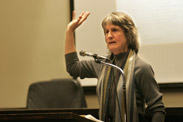Nature, culture and inappropriate love objects
Nature, culture and inappropriate love objects McGill University
User Tools (skip):
Nature, culture and inappropriate love objects

Cultural theorist Donna Haraway, from the University of California, Santa Cruz
Owen Egan
Donna Haraway shares an intimate moment with her audience. "This is Cayenne as a puppy," she says, and the slide on the screen shows an adorably scraggly young dog. On Thursday, February 17, hundreds packed into the Moot Court at New Chancellor Day Hall and discovered plenty about Haraway's dogs Cayenne and Roland in her presentation "We have never been human: companion species in naturecultures." But the dogs were simply a handy case study for the hefty philosophical thesis, an argument for "naturecultures," underpinning her talk, which was the 2005 Elizabeth B. McNab Lecture in the History of Science in the Donald Mossman Lecture Series in the History of Science and Ideas.
Since her 1991 Simians, Cyborgs and Women: The Reinvention of Nature, Haraway has been a must-read for cultural theorists of all breeds. She received her PhD in biology from Yale in 1972, and since 1984 has been a professor in the History of Consciousness Department at the University of California at Santa Cruz, teaching feminism, animal studies and science studies. A writer who describes herself as a "lapsed Catholic and a lapsed biologist," she blends the personal, historical and analytical in an insightful and compelling mongrel of academic prose. As a speaker she is similarly engaging, allusive, anecdotal and challenging.
"Companion - com-panion - means 'with bread,'" she notes. Companion species - and most of her examples were canine, though she stresses that they needn't be - are those with which we share meals, literally or metaphorically, and they can dissolve the border between animal and human, as any attentive pet owner will agree. A willingness to engage with how our animal "others" regard us drags us from Western philosophy's long-established delusion of the differentiated independent subject, she argues. "My work is an effort to explore the ways we create and participate in categories. We're part of a crowd, with other species and environments. Nature is not something to define ourselves against, but rather something to be a part of."
Halfway through her talk, Haraway contrasts two anecdotes of the animal gaze gleaned from academic writings: one from Jacques Derrida, famed French philosopher, and another from Barbara Smuts, author of Sex and Friendship in Baboons. Derrida recounts being watched by his cat as he prepares to shower, and then analyzes the shame that he feels under the cat's gaze. But, notes Haraway, the cat, once used to make the point, then disappears as Derrida concerns himself with his own response to being eyeballed by the cat - not with what it is that the cat might be seeing.
Smuts, on the other hand, recounts doing field research among baboons. Her first strategy on arriving upon baboon turf is to "neutralize" herself by sitting very still in the hope that the primates will think of her as akin to a rock, and will thus behave as if she were not there. This tactic does not work; eventually, she realizes that the baboons are pondering her capacity for proper etiquette and interaction. Is she, they wonder, educable? Or is she as dense as the rock she seems to be emulating? Once she demonstrates the capacity to engage with the baboons, they accept her and let her observe their daily lives. The two anecdotes demonstrate alternative means of engagement with companion species - and to Haraway, the difference comes down to respect for the other.
This attitude also extends to the histories and conditions that lead to the present. "All love objects worthy of the name are inappropriate love objects," she says to laughter. "I love a couple of Australian shepherds. And what do I touch when I touch that dog?" Australian sheepdogs are not Australian at all - they are a western North American breed used in 19th-century California, to herd sheep that had been imported from Australia. "So I touch the California gold rush, the colonialization of native cultures, the collapse of the Spanish colonies, the transportation of sheep from Australia to California, and a host of other histories." We inherit history by inquiring into this touch, she stresses. "Every relationship with an inappropriate love object carries responsibility." It connects us to a range of historical threads and realities, forcing us to acknowledge the complexity of our relations, to live fully in the world and to not assume that we can place ourselves apart.
In the Moot Court, of course, we are apart; the only non-human critters are those that appear on the screen above. Haraway's analysis of the human/animal dichotomy is underscored by the absence of animals, and a state normally taken for granted in the university suddenly seems a bit odd. How, and what, would we learn if there were more cats strolling through the lecture halls of academe?
